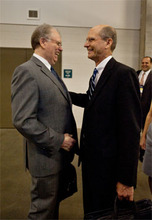1 Jul 2010, Atlanta, Georgia, United States…Edwin Manuel Garcia/ANN
U.S. President Barack Obama enjoyed a 77-day transition period from election to inauguration.
Pacific Union College President Heather J. Knight took 81 days to prepare for her new job.
But when Ted N. C. Wilson was elected leader of the 16.3 million-member Seventh-day Adventist Church on Friday, he was given less than two hours to leave his old job and settle into the new one during the 59th General Conference Session in Atlanta.
The speedy timeframe may seem incredibly brief for a job with such a significant responsibility, but it’s also part of a well-established practice at every General Conference Session, and church officials are confident that the process works.
Presidents aren’t the only ones who undergo a quick transition. Dozens of church leaders elected during the 10-day Session from June 23 to July 3 start their new jobs — or continue in their positions, in the case of incumbents — effective immediately after a vote of the delegates.
But nowhere is the transition more fast-paced than in the presidency, where the newly elected leader’s life changes dramatically in a matter of minutes.
He’s instantly assigned a security detail that zips him from place to place, sometimes through secret passages to avoid crowds. He’s suddenly the top leader at the early morning planning meeting where he was merely a participant the day before. He gets to exert influence over the Nominating Committee, which selects the leaders who work with him for the next five years.
Oh, and if there’s time, his scheduler carves out as many appointments as possible with former President Jan Paulsen to help ease the transition during Wilson’s first whirlwind week in office.
“Everything moves at warp speed, oh my, it’s unbelievable,” said former President, Robert S. Folkenberg.
“It’s sensory overload, spiritual overload, and information overload,” added Folkenberg, the church’s top leader from 1990 to 1999, who recalled how he shifted from being Carolina Conference president to General Conference president in a manner of minutes.
The coming challenge
Those who know Wilson say he’s up for the challenge, thanks to his background and experience: He’s the son of a former world president, Neal Wilson, and was a longtime General Conference vice president.
“He is pretty well acquainted with some of the issues that will have to be dealt with,” said Orville D. Parchment, assistant to President Paulsen since 2003, and, as of last week, the assistant to President Wilson.
The quick transition “seems very sudden to an outsider,” observed Heather J. Knight, president of Pacific Union College in Northern California, “but in reality, he was very, very well prepared.”
Still, having more time to prepare for a new job has its benefits, said Knight, a former Andrews University official who accepted her position at PUC on June 17, 2009, and started working there nearly three months later.
During the transition, she prepared a 5-inch-thick binder of instructions for her successor at Andrews; traveled to California to meet with her new leadership team; and developed goals for the new job.
“It’s never really enough time, but when God calls you to do something,” Knight said, “He also empowers you to get the task done.”
Morning meetings
The new General Conference president wakes up before sunrise for his personal devotional, and then attends the 6:45 a.m. Steering Committee meeting, where he sits at the head of a rectangular conference table surrounded by and vice presidents and other officers who help set the Session agenda for the day.
“You move from being a participant or an observer to suddenly providing informed guidance,” Folkenberg said. “It’s just incredible.”
After the morning gathering, Wilson slips into back-to-back meetings, some of them in a temporary, cubicle-paneled office that’s been assembled for him in the Georgia World Congress Center, which is nearly identical to an office from where the soon-to-retire Paulsen works across the hall.
It’s not uncommon for Wilson to attend late-night meetings after the evening program in the Georgia Dome, which typically let out after 9 p.m.
After Session concludes this weekend, Wilson will return to Silver Spring, Maryland, and move into the president’s office about 40 feet down the hall from his current office.
Then his invitation calendar will begin to fill. And fast.
“The new president will start taking appointments, and his appointments in a little while — I would say within a month or two — will stretch into two, three years,” Parchment said. “There’s no honeymoon period.”
